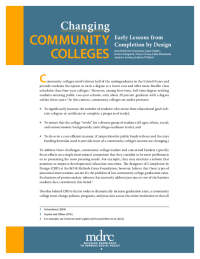Changing Community Colleges
Early Lessons from Completion by Design

Community colleges enroll almost half of the undergraduates in the United States and provide students the option to earn a degree at a lower cost and offer more flexible class schedules than four-year colleges. However, among first-time, full-time degree-seeking students entering public two-year schools, only about 20 percent graduate with a degree within three years. In this context, community colleges are under pressure:
-
To significantly increase the number of students who attain their educational goals (obtain a degree or certificate or complete a program of study);
-
To ensure that the college “works” for a diverse group of students (all ages; ethnic, racial, and socioeconomic backgrounds; and college-readiness levels); and
-
To do so in a cost-efficient manner. (Competition for public funds is fierce and the state funding formulas used to provide most of a community college’s income are changing.)
To address these challenges, community college leaders and concerned funders typically focus efforts on a single institutional component that they consider to be most problematic or as presenting the most pressing needs. For example, they may institute a reform that promises to improve developmental education outcomes. The designers of Completion by Design (CBD) at the Bill & Melinda Gates Foundation, however, believe that these types of piecemeal interventions cannot fix the problem of low community college graduation rates. Evaluations of postsecondary reforms that narrowly address just one or two of the barriers students face corroborate this belief.
Conceived in 2010, CBD is a five-year initiative that works with nine community colleges in three states. The goal of CBD is to substantially increase completion rates for these students, while holding down costs and maintaining access and quality. To achieve this daunting goal, CBD asks colleges to change their mindset from “fixing a problem” to “designing new or dramatically different systems.” This type of comprehensive approach to reform requires systemic change.
This brief aims to provide college and higher education system leaders, as well as concerned funders and policymakers, with a framework for thinking about systemic change. It also provides insights from the CBD experience that can help others considering similar initiatives to develop implementation plans that are sufficiently broad and appropriately staffed, structured, and resourced. The brief first explains how systemic change is different from other, more incremental changes that colleges often implement and why systemic change is difficult but necessary. It then draws lessons from the experiences of five CBD case study colleges during the first two years of implementation.






